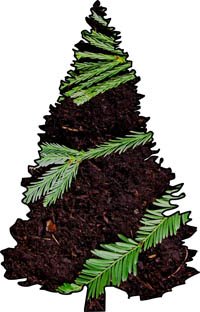
Coast Redwoods Facts
Continued from: Coast Redwoods Main Page

advertisement
Page last updated November 5, 2015. Copyright 2010 - 2015 - Mario D. Vaden

Tallest Redwood
The tallest coast redwood recorded, named Hyperion, measured 379.3' or 115.61 meters shortly after it was discovered. Located in Redwood National Park and discovered 2006. Before that one, Stratosphere Giant near Avenue of the Giants was tallest. Before the Strat, Dyerville Giant near Founders Grove and the Mendocino redwood farther south. The heights of the 5 tallest have been changing a little both up and down. The names may not be published along with data updates in the future. One was reported as breaching 380 ft. around 2014.
Largest Coast Redwood
Some sources used to claim Lost Monarch in Jedediah Smith Redwoods State Park, with 42,500 cubic feet, as the largest coast redwood. But Dr. Robert Van Pelt in his Forest Giants book noted that Lost Monarch is actually two trees to get that number. The huge big stem, plus a 6,000 cubic foot giant sprout from the ground at it's base. That left Iluvatar in Prairie Creek as the largest known for quite a while, with roughly 37,500 cu. ft.; it was the same redwood photographed for National Geographic's October 2009 issue.
Presently, Grogan's Fault is the largest known single stem coast redwood, with over 38,000 cu. ft. in just the main trunk alone, not counting any extra trunks up in the canopy or off the main trunk.
Widest Trunk
The widest trunk used to belong to Lost Monarch too, at least 1998 to 2013. 26' diameter at dbh (4.5' above grade). The 30' base at ground level was wider than 4 Humvees side to side.
But several new diameter champions were discovered in 2014 and 2015, all at least 27 ft. wide at dbh. The widest, at 29.2' diameter dbh, was named Jupiter, located in Redwood National and State Parks. One of the previous diameter champions name Crocodile, was noted to be in Redwood National Park.
Branches
The size of branches can range from fractions of an inch thick, to as thick as 5 to 7 feet in diameter observed on some old-growth redwoods. One coast redwood called Kronos had a branch diameter close to 7 ft. thick.
Reproduction
Coast Redwood reproduce naturally several different ways:
Seed germination
Stems sprouting from roots of existing redwoods
Layering, where branches or twigs root after breaking, falling and maintaining contact with soil.
Stems growing from burls on stumps, or from fallen trunks.Fossils
Paleontologists have found fossils, classified as redwoods, dated to the Cretaceous period which ended 65 million years ago. There are about 12 different fossil redwood species known. The oldest evidence are leaf fossils of Sequoia jeholensis from the Jurassic era (beginning of the Cretaceous period). The leaf imprints resemble present day coast redwood, as do others of the dozen or so fossil species. The most common fossil is not easily distinguished from the living Sequoia sempervirens. But due to it's great geological antiquity, it is called Sequoia langsdorfii
Historical Range
Redwood fossils have been found near the Bering Sea (St. Lawrence Island), Texas, Pennsylvania, Colorado, Wyoming, Oregon, Washington, California, Canada, Greenland, Alaska, France, Switzerland, Austria, Bohemia, Germany and England. There used to be vast redwood forests.
Largest Redwood Ever

The largest known coast redwood ever, was the Lindsey Creek redwood with about 90,000 cubic feet: at least 6,000,000 to 7,000,000 pounds. It fell during a 1905 storm. That redwood was about 80% larger than General Sherman (Sequoiadendron), and dwarfed any of the largest Giant Sequoia living today.
Foliage
Redwood have evergreen needle foliage. The size is variable. Older taller redwoods may have needles near the top that look as small as Giant Sequoia foliage. There may be two white stomatal stripes on the underside of the needles: tips are pointed. On young redwoods, or lower branches of bigger redwoods, 0.5 to 1 inch long needle-like leaves is typical.
Limits of Height Growth
The theoretical limit for coast redwood is 122-130 meters / 410-425 feet, related to gravity and effects of friction on water moving through vessels within wood (Koch & Sillett 2004). A redwood claimed 115.8 meters / 380 feet was felled 1914. Another claimed 129 meters / 424 feet was felled 1886 by Elk River Mill and Lumber Company: South Fork Elk River, Humboldt County.
Largest Coast Redwood Photographed
The Crannell Creek Giant is the largest known coast redwood for which there is a photograph. One image is available at Blue Lake Museum in north California. This redwood was 60,000 to 70,000 cubic feet: larger than any living Giant Sequoia.
Seeds
It takes about 120,000 Coast Redwood seeds to make one pound. Each scale of a redwood cone can produce about 3 to 7 seeds. Each cone (female) has about 15 to 25 scales. Seeds are released as cones mature and open. Each seedabout 3mm - 4mm.
Flowers and Cones
Redwoods are monoecious, meaning that male and female flowers (inconspicuous) are on the same plant. The male flowers are tiny: about 1/4 inch. The female flowers are also small, and develop into cones that are about 1 inch long give or take. The flowers and pollination occurs late autumn and in winter. Female cones take 8 to 9 months to mature, opening around September.
Natural Range
Coast redwoods grow in a narrow coastal strip from Big Sur Coast in central California to extreme southwestern Oregon. About 450 miles north to south. The north end is 2 groves on the Chetco River in Oregon, and the south end Salmon Creek Canyon in Santa Lucia Mountains of Monterey County, CA.
Albino Redwoods
The rare albino redwoods (less than 100 known) can produce cones with seeds. In one experiment, the germinated seeds produced white seedlings, variegated seedlings and green seedlings. The white ones did not survive. Albino redwoods lack chlorophyll and for survival are attached to other coast redwoods that have green foliage ..... 11/5/2014 update: find my albino redwood page from the menu. But over 100 albino redwoods are now known to exist.
Greatest Known Biomass
After measurement, one stand of coast redwoods in Humboldt State Park had the greatest biomass ever recorded on Earth, with a stem biomass of 1,544 tons per acre.
Water
Redwoods like other plants, get a lot of water from the ground. But fog moisture is very important too ("Fog prevents water loss from redwoods in summer, and is really important" - Todd Dawson, UC Berkeley). In summer when fog is most frequent, isotopic data indicated 8-34% of water used by coast redwood, and 6-100% of water used byunderstory vegetation came from fog precipitation after it dripped from foliage to the soil. Coast Redwoods are water-collectors.
Increased humidity during hours when fog is present also reduces water loss from needles.
Occassionally, it is possible for coast redwoods to intake fog water, with that water moving down the stem to some extent (American Journal of Botany article - 2009 - Koch & Siillett).
As a Forest
Animals
Over 200 hundred vertebrates are found in redwood forests, including salamanders, newts, snakes, shrews, beavers, mice, lizards, bats, squirrels, chipmunks, weasels, deer, elk, bears, frogs, turtles, voles, mountain lions, otters, and woodrats.
Birds
Nearly 100 bird species from 28 families abide in redwood forests, including marbled murrelet, wood warbler, tanager, sparrow, blackbird, Allenís hummingbird, woodpecker, bald eagle, sharp-shinned hawk, purple martin and winter wren. Likewise raven and crows, which can be a nuisance.

advertisement